
ThinkEnergy
Hydro Ottawa

1 Creator

1 Creator


3 Listeners
1 Comment
All episodes
Best episodes
Seasons
Top 10 ThinkEnergy Episodes
Goodpods has curated a list of the 10 best ThinkEnergy episodes, ranked by the number of listens and likes each episode have garnered from our listeners. If you are listening to ThinkEnergy for the first time, there's no better place to start than with one of these standout episodes. If you are a fan of the show, vote for your favorite ThinkEnergy episode by adding your comments to the episode page.
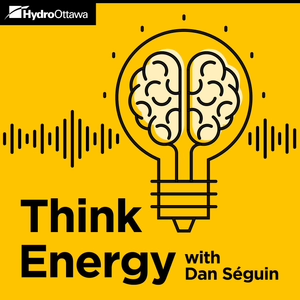
The Power of Influence
ThinkEnergy
06/22/20 • 44 min
Brands are struggling to find a new way to authentically connect to their customers and we are witnessing major communication disruptions. In an article that appeared in Adweek, Twitter said that users now trust influencers like YouTubers, almost as much as their friends. This is the age of influencer marketing. So here's today's big question. Should brands consider adding influencer marketing to their everyday marketing mix and is there a right way, and a wrong way to do it. Neal Schaffer, author of ‘The Age of Influence” gives us the scoop.
Related Content & Links:
- https://hydroottawa.com/
- Twitter feed: @NealSchaffer
- Amazon link to book: The Age of Influence: The Power of Influencers to Elevate Your Brand on paperback
- Website: nealschaffer.com
- Apple podcast link- Maximize Your Social Influence Podcast
Transcript:
Dan Seguin 0:02 Hey everyone! I'm Dan Segin from Hydro Ottawa. And I'll be hosting the ThinkEnergy podcast.
PewDiePie, Dude Perfect, Hola Soy German, Whindersson Nunes, and El Rubius. While perhaps not household names to you and I, they are powerful influencers to Gen Z's audiences aged 13 to 18. In fact, these youtubers combined have 262 million subscribers, and are more influential to this generation than movie stars and politicians. It's not surprising that today's consumers are increasingly more savvy and critical of branded advertising. Gone are the days where advertising messages and propositions were trusted and taken at face value. In an online world where advertising is seen as more intrusive than valuable.
Brands are struggling to find a new way to authentically connect to their customers, we are witnessing major communication disruptions. This includes declining television viewership, continued growth of social media audiences, an increase in ad blocking technology media Fasting, and a significant rise of noise clutter on all channels. It's becoming increasingly more difficult for brands, particularly energy brands to keep up with the digital landscape, as consumers take extreme measures to avoid being advertised to. With demand for attention on the rise and overwhelming product options on the market, consumers are beginning to lose sight of who they can trust. Is the energy industry facing a Kodak moment? In an article that appeared in Adweek, Twitter said that users now trust influencers like YouTubers, almost as much as their friends. This is the age of influencer marketing. So here's today's big question. Should brands consider adding influencer marketing to their everyday marketing mix and is there a right way, and a wrong way to do it. Our guest is no stranger to social media and the marketing world. He's the author of three books, teaches digital media to executives at New Jersey Business School, has a podcast called maximize your social influence, orchestrates digital transformation for leading businesses and is fluent in Japanese and Mandarin Chinese. Dear listeners, please welcome Neal Schaffer. Hey Neil, how would you define influencer marketing? And can you give us some examples of brands doing it well?
Neal Schaffer 3:48 Thanks Daniel. So influencer marketing is something that I think a lot of people are mystifying or they're mis educated on or they've been misinformed about. You know, when I look at influencer marketing, I look at Who has online influence? Who has digital influence? So, yes, celebrities have digital influence. But there's a lot of other people that I've influenced because there's so many of us that use social media that build communities, in the hundreds in the thousands in the 10s of thousands, but even those people that have communities in the thousands are still able to influence others, right. And even in the influencer marketing industry, where they have gone smaller and smaller, you know, with each year we they used to talk about macro influencers, then mid tier influencers, and then micro influencers, which are people that have between, you know, 50 to maybe 500,000 followers. And then over the last year or two, we talked about nano influencers, people with one to 10,000 followers. And if you think about, you know, I don't know about Canada, I'm assuming it's pretty similar demographic wise, but in the United States, the majority of the workforce are millennials. So these are digital natives that have been doing social media since it began. And they've bui...


2 Listeners
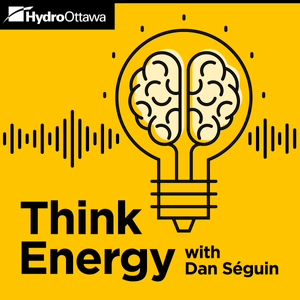
Why We're Falling 'In Like' with E-Bikes
ThinkEnergy
08/17/20 • 32 min
When we talk about the electrification of transportation, we tend to think about electric vehicles or light rail transit. But there’s another sub-genre of electric transportation that is rapidly growing in popularity: e-bikes. In this episode, Seth Weintraub, an award-winning tech journalist and blogger, helps us tackle some of the myths surrounding e-bikes and helps us understand why they’re becoming one of the greenest transportation options when it comes to urban traffic and environmental impact.
Related Content & Links:
- Websites: https://www.electrek.co
- Linkedin: Seth Weintraub - https://www.linkedin.com/in/sethweintraub/
- Twitter: Seth Weintraub - @llsethj
- Great ebike reviews on YouTube: https://www.youtube.com/c/electrekco
Transcript
Dan Seguin 00:02
Hey everyone, welcome back. This is the ThinkEnergy podcast. When we talk about electrification of transportation, we tend to think about electric vehicles, buses, or light rail transit. But there's another subset of electric trains Transportation that is rapidly growing in popularity. With improvements to battery storage, we may just be entering a new golden age of transportation and mobility, driven by a range of factors from climate change technology, economics, in general consumer preference, the evolution of electric transportation is changing the landscape faster than we've seen in our history. Certainly the awareness of our own responsibility to reduce our own overall impact on the environment is a significant factor. The accounting firm Deloitte says that 300 million electric bikes will be out worldwide by 2023, which is 50% more than today, urban dwellers in particular are seeking convenient, eco healthy and affordable ways to move around congested cities. A criticism has been that e-bikes don't contribute to exercise since the motor does most of the work for you. But a new university of Boulder Colorado study shows that using an electrically powered bicycle on a regular basis can actually provide riders with an effective workout while improving some aspects of cardiovascular health, especially for riders who were previously inactive. The researchers noticed improvement in the rider’s cardiovascular health, including increased aerobic capacity and improved blood sugar control. E-bikes and scooters are affordable now. They are efficient to operate, reduce congestion and ease commute times. They do increase physical activity and simply put - a lot of fun. Yes, e-bikes have a higher emission than a regular bicycle but they far outperform cars, including electric ones, similar to EV's e-bikes can help communities achieve their GHG emission reduction targets. What's interesting is that half of all e-bikes driving trips are shorter than 16 kilometers, with some averaging single trips of just nine kilometers. That's a no brainer distance to cover by e-bikes. Studies show that e-bike owners are replacing 46% of their car commutes, and 30% of their driving errands with a bike rides. Of course, like other electric forms of transportation. This takes support, buy in, and infrastructure investments from municipalities. With supportive cycling infrastructure in place e-bikes have the potential to substitute or completely replace almost all trips taken by a gasoline powered car -which could address congestion and pollution issues and mitigate parking challenges within urban areas, especially for downtown dwellers. So here's today's big question: Are two wheels better than four? In addition to tackling some of the myths surrounding e-bikes are the greenest transportation option when it comes to urban traffic, and environmental impact. Joining me today is a very special guest, Seth Weintraub, an award winning journalist and blogger. In 2003, Seth bought one of Tesla's first model S EVs off the assembly line. This began his love affair with electric vehicles and green energy, which he turned into electrek.co. Seth, I only scratched the surface of your bio in my introduction. Can you tell us a bit more about you, your work, and why electric transportation technology and the environment mean so much to you?
Seth Weintraub 05:14
Alright, so my background is in engineering, I went to school for engineering got my post grad engineering. But I started about 10 years after I began my career in writing about technology. And that started with Apple and started 9to5Mac, about 12 years ago. And then that expanded to Google covering Google and covering, you know, the wider technology range. My interest in clean energy kind of began, when I got a Prius, but really kind of everything came together when I bought my first fully electric car, which was a 2013 Tesla. Model S, you know, I got it at...
1 Listener
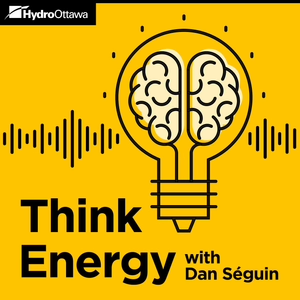
The Future of Autonomous Vehicles
ThinkEnergy
06/08/20 • 32 min
Have you ever dreamed of the day your car can drive itself? The accelerating rate of research and development in automation and artificial intelligence is indicating that this dream may become a reality very soon. Raed Kadri, the Head of Ontario’s Autonomous Vehicle Innovation Network, shares about the different levels of autonomous driving, the benefits from an individual and city-wide level, and the incredible opportunities behind developing this technology.
Related Content & Links:
- https://www.avinhub.ca/

1 Listener
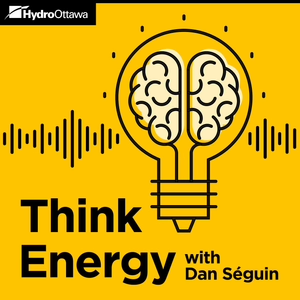
What’s in Store for Energy Storage?
ThinkEnergy
11/09/20 • 17 min
Does energy storage hold great potential for a Canada in which wind and solar power could dominate new power plant additions and gradually overtake other sources of electricity? How can energy storage make up for the current limitations of renewables? Find out if energy storage, particularly electricity storage, is the missing piece in the renewables jigsaw as Justin Rangooni, Executive director of Energy Storage Canada, shares his perspective.
Related Content & Links:
- https://hydroottawa.com/
- Websites:
- Twitter: @EnergystorageON
- LinkedIn: https://www.linkedin.com/in/justin-rangooni-5063b542/
Transcript:
Dan Seguin 00:42
Hey, everyone, welcome back. This is the ThinkEnergy podcast. If you're following energy trends around the world, you've likely heard about energy storage. It's a big topic, and there's a lot to unpack. While there are many types of systems to store energy, I think it's easiest to think of energy storage as the battery that you use to capture energy when it's produced, so you can use it at another time, perhaps when energy isn't available, like during a power outage. With renewable energy continuing to grow in Canada, where does energy storage fit? You have to wonder if energy storage will become the new power plants of the future. One thing is certain energy storage will play an important role in the future supply mix for electricity, most obviously, in creating a more flexible and reliable grid system. For example, when there is more supply than demand, such as during the night when energy costs are lower and power plants continue to operate, the surplus electricity generation can be sent to power energy storage systems, instead of being sold at a loss or going to waste. While wind and solar are great. They can only produce energy at a certain time. This reality has been a barrier for mass integration into modern electricity grids. Since the constant availability of reliable power is paramount to the country and our economy, a complimentary technology like energy storage could help fill the gap for managing today's renewables. Synergies between wind energy, solar energy and energy storage also mean that these technologies can provide a broader range of services to the grid when used in a coordinated manner that reduce overall electricity systems costs, such as building new and expensive generating plants. But at what scale are we at for energy storage today? And where is it headed in the near future? Is there a strategy and evidence that energy storage is a solution we're looking for? In short, where is Canada at on the energy storage journey to adoption? This leads me to today's big question: is energy storage the missing piece in the renewables jigsaw puzzle? And the solution for Canada's energy needs? Joining me today is a very special guest. Justin Rangooni, the executive director at energy storage Canada, who's here to help us unbox the energy storage mystery. Justin, welcome to the ThinkEnergy podcast. Justin, can you tell us a bit about yourself? What energy storage is and what your organization Energy Storage Canada does what it's all about?
Justin Rangooni 04:04
Of course, Daniel, and thanks for having me on the chat. Always glad to chat with you and see our friends at Hydro Ottawa. Again, well, Energy Storage Canada is the National voice for energy storage. We are the only Association dedicated to advancing energy storage in the country. We have over 60 members from across the energy storage value chain from the biggest global companies to the most innovative startups. And we develop policy positions, advocate and educate decision makers and host educational and networking opportunities through webinars and our annual conference. We're basically energy storage 24 / 7, 365 days a year.
Dan Seguin 04:43
Cool. Okay, at a high level, what are we talking about in terms of large scale or grid scale energy storage? What sizes are available? How long can the energy be stored for and is the goal to power cities for days or weeks?
Justin Rangooni 05:02
Not a good question again, what makes energy storage so unique is the varying degrees of sizes, capabilities and technologies. In terms of larger grid scale, you know, we're talking about projects in the hundreds up to 1000 megawatts. But energy storage projects can be in the kilowatts as well, it all depends on the project and where it's located. And depending on the discharge rate of how much energy is injected back into the grid, it could be a couple hours or even more, again, all depends on the technology and the capabilities. And the goal for the sector is really to optimize generation, optimize dis...
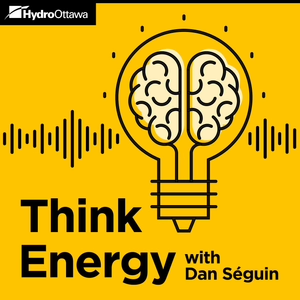
Shifting into Renewable Gear (Rebroadcast)
ThinkEnergy
07/26/21 • 31 min
---Join us for our Summer Rewind series as we feature past podcast episodes!--- EPISODE #33:
Compared to conventional methods of energy generation, like fossil fuels, greenhouse gases emitted from renewables are little-to-none; making them the cleanest, most viable solution to prevent environmental degradation. In this episode, we invite Brandy Giannetta, Senior Director at Canadian Renewable Energy Association, to discuss renewable energy and the realistic strategies for increasing its supply to permanently replace the remaining carbon-intensive energy sources in Canada.
Related Content & Links:
- https://hydroottawa.com/
- Websites:
- Canadian Renewable Energy Association https://renewablesassociation.ca/
- Linkedin: https://www.linkedin.com/in/brandy-giannetta-45872539/
Transcript:
Dan Seguin 00:02
Hey, everyone. I'm Dan Seguin from hydro Ottawa. And I'll be hosting the think energy podcast. Are you looking to better understand the fast changing world of energy? Join me every two weeks and get a unique perspective from industry leaders as we deep dive and discuss some of the coolest trends, emerging technologies, and latest innovations that drive the energy sector. So stay tuned as we explore some traditional and some quirky facets of this industry. Hey, everyone, welcome back. This is the ThinkEnergy podcast. We've all heard the saying 'it's not easy being green'. But when it comes through renewable generation, is that true? With all the scientific evidence out there, being a climate change denier is becoming more and more synonymous with being a flat-earther. It's clear that humans have been polluting our atmosphere with carbon dioxide and other global warming emissions. NASA, the World Health Organization and the United Nations say we have to change the way we live, work and play. As we face our own extinction, what is the answer? Do we have the courage to be green? Are we okay with it not being easy. That brings us to renewable energy. How easy or difficult is it? How does it improve our health, environment and economy? Where is Canada at? And are we on track to becoming a global climate leader? Are we leveraging renewable energy within the electricity system. And do we have enough new renewable capacity to power our energy needs compared to conventional methods of generation like fossil fuels, greenhouse gases emitted from renewables our little to none, making them the cleanest, most viable solution to prevent environmental degradation. Renewable sources of electricity have powered Canada for more than a century. According to Natural Resources Canada, renewable energy sources currently provide about 17% of Canada's total primary energy supply, with wind and solar as the fastest growing in the country. So here's today's big question. What is a realistic strategy to increasing the supply of renewable energy so that we can permanently replace the remaining carbon intensive energy sources in Canada. And what would the global impact be? Joining me today is Brandy Giannetta. From the Canadian Renewable Energy Association, Brandy is a regional director responsible for promoting, communicating and advocating for adoption of the associations policies, with political representatives, members of government, media, and other key stakeholders and decision makers. Brandy, welcome to the show. Maybe start us off by talking about the Canadian Renewable Energy Association. its mandate and why it's important for Canada.
Brandy Giannetta 03:46
Sure thing! Well the Canadian Renewable Energy Association: We are a national Industry Association is we we see ourselves as the voice for wind energy, solar energy and energy storage solutions, here in Canada with the goal of powering Canada's energy future. So our association really works to create the conditions for modern energy solutions vis-à-vis stakeholder advocacy, public engagement at several different levels. So we are a multi Technology Industry Association and we are new. We are looking again to provide that unified voice for renewable energy as well as energy storage across Canada. So we're the product of uniting what was the Canadian Wind Energy Association with what was the Canadian solar industry association so CANWEA and CANSIA our well-known names as having had decades of advocacy in Canada on behalf of the wind sector in the solar sector in Canada. And now we're one new expanded Industry Association, so very exciting, which also now includes, of course, energy storage. So that's in recognition of that pivotal role that energy storage is going to play alongside those renewable technologies as we look to transform Canada's energy mix.
Dan Seguin 04:59
What is the Canadian Renewable En...
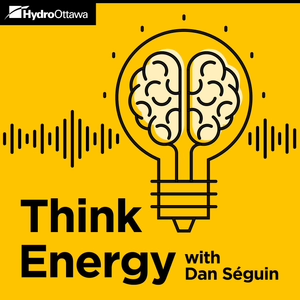
08/09/21 • 33 min
---Join us for our Summer Rewind series as we feature past podcast episodes!--- EPISODE #34:
What happens when you use a network of hot and cold water pipes, bury them underground, and then use them to efficiently heat and cool buildings – or even whole communities? You get something called district energy. In this episode, Jeff Westeinde, President of Zibi Canada and Founding partner of Windmill Development Group, shares his passion for environmental sustainability, designing communities to support One Planet Living, and leveraging age-old systems like district energy as a means of achieving a zero carbon footprint.
Related Content & Links:
- Hydro Ottawa – https://hydroottawa.com/
- Zibi Canada – https://www.zibi.ca
- Linkedin - Jeff Westeinde: https://www.linkedin.com/in/jeff-westeinde-a46b4843/
---------------------------
Transcript
Dan Seguin 00:02
Hey, everyone, welcome back. This is the ThinkEnergy podcast. What happens when you use a network of hot and cold water pipes, bury them underground and then use them to efficiently heat and cool buildings - even whole communities, you get something called 'district energy'. And it's not a new concept. A quick search will reveal that its origins can be traced back to the second century BC to the invention of the hypocaust heating systems that powered the hot water bath of the ancient Roman Empire. Famously a hot water distribution system in Chaudes-Aigues, in France, is regarded as the first real district heating system. It used geothermal energy to provide heat for about 30 houses in the 14th century, and the US Naval Academy in Annapolis began steam district heating in 1853. If you're like me, maybe you're wondering why modern civilization did not continue to use this efficient and environmentally sustainable technology more. There are some European countries such as Denmark, where district energy is mandated, but for the most part, it is largely gone the way of ancient Rome and public bathing. The latter is not such a bad thing in my mind, with more and more socially conscious citizens around the globe, district energy is once again seeing a surge in popularity and becoming a preferred method, thanks to its lower and energy efficient operating costs, reduced supply disruptions, and environmentally sound methods of heating and cooling buildings, municipalities and property owners are intrigued by this ancient alternative energy technology. So, here's today's big question: Is the world ready to embrace district energy as a viable means to power our communities? Is the nation's capital ready to have the first one planet zero carbon community district energy system in the country? Well, my guest today is the founding partner of the THEIA partnership. One of Canada's most sustainable real estate development companies, as well as the president of Zibi Canada, which aims to be Canada's most sustainable development project. He's also an active investor and entrepreneur in both environmental, clean tech and real estate sector with active investments in solar energy, site remediation, and the beneficial reuse of waste. Dear listeners, please welcome Jeff Westeinde. Jeff, can we start by you telling us a bit about your background, the Zibi project and what drives your passion to build sustainable communities?
Jeff Westeinde 04:02
Well, so I guess my background, I always say I'm an entrepreneur. I'm an engineer by training, but entrepreneur by practice. So I've, I've had one, what I call real job in my career, I worked for a company for a little over a year, it quickly became apparent that I was unemployable. So I had to start my own business. And I've always been in the environmental sector. So I started I started my career as an environmental contractor cleaning up industrial messes and some of the wastes of the past. And as part of that, I would watch our clients the way they were cleaning up properties, and then what they would do to redevelop them. And I was pursuing trying to, you know, clean up the environment, make the planet a better place. And yet, so the practices we were using, were actually making it worse. We're trucking contaminated soils. You know, the time I lived in BC, we're picking up soil, putting it in a dump truck and hauling it across the Rocky Mountains into a landfill in Alberta. And nobody can tell me that's good for the environment. So very good. quickly decided that we shouldn't say very quickly but decided while I continue to move up the food chain, and start to buy contaminated properties and start to develop places and communities. And because we were purchasing contaminated properties, the commitment that we had was, let's do better than we've done before. So let's push the envelope about how can we...
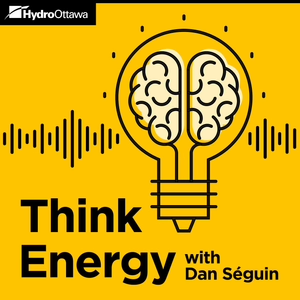
The Critical Decade of Building Green
ThinkEnergy
06/07/21 • 48 min
From policy to infrastructure to new and old buildings, how can we create cities that improve lives through deep carbon reductions, creating co-benefits for people and the planet? Thomas Mueller, President & CEO at Canada Green Building Council, joins us to share why this is a ‘critical decade’ for the green building market and why green buildings are an actionable solution for helping Canada meet its goals for economic development, job creation, and GHG reductions.
Related Content & Links:
- Thomas Mueller - President & CEO at Canada Green Building Council (CaGBC) CEO, Green Business Certification Inc Canada (GBCI CA)
- Canada Green Building Council - https://www.cagbc.org/
---
Transcript:
Dan Seguin 00:02
Hey everyone, welcome back to the ThinkEnergy podcast. As cities struggle with the pressure to reduce greenhouse gas emissions, better support green jobs, and hyper competitive real estate markets, they must find new and creative solutions that address short and long term issues. This includes creating a low or zero carbon future, which requires a step by step process to retrofit our existing communities and ensure all future builds are net zero carbon operations by 2050. From policy to infrastructure to new and old buildings. How can we create cities that improve lives through deep carbon reductions, creating co benefits for people and the planet. As of 2018, the green building industry added over 164,000 jobs, which is 55% greater than 2014. Over the same period, Canada's oil and gas extraction, mining and forestry industries stagnated in terms of job growth, they contracted by 2.8% and shed 7580 positions. Canadians have grown conscious of a broader range of social and environmental challenges. This shift and resulting public pressure have in turn spurred policymakers and industry leaders to raise the bar on sustainability, leading to increased government activity and higher standards for both building codes and industry certifications. As a result, green building certification programs are not only growing increasingly stringent, but also broadening in scope. Over the past decade, they have raised the bar on energy efficiency, renewable energy and sustainability practices. By extension, they have changed the way Canadians design, construct, maintain and operate buildings. A large percentage of Canada's buildings continue to be constructed without green building practices, or third party certification. building codes and municipal bylaws in provinces such as British Columbia are driving market transformation via new construction. So here's today's big question: is the existing building market really the most significant untapped opportunity for economic development, job creation, and GHG reduction in Canada? Our guest today leads the Canada Green Building Council national green building strategy, programs and standards, along with advocacy and policy initiatives. He's also the founding director of the Canada Green Building Council, and became president and CEO of the council in 2005. Dear listeners, please welcome Thomas Meuller. Thomas, you're a well known advocate for green buildings and sustainable community developments. Perhaps you can start by telling us a bit about yourself, What drew you to your current role? And what the Canada Green Building Council does?
Thomas Mueller 04:09
Thank you for inviting me. My name is Thomas Mueller. I'm the president and CEO of an organization called the Canada Green Building Council. And we've been advocating for green building practices since 2005. And, and we are really focusing on changing the practices in the billing industry ever since what really drew me to this to this work was that I, you know, I was inspired at the time and this is a long time ago by our common future, which was the Frampton report, as it was referred to the first mention of sustainable development and didn't take me long to realize that the building sectors, one of the sectors that have there's no other sector in the world has more impact, not just on climate change, but also how we live and our economy than the building sector. So that in the late 1990s, I was drawn to that sector to make changes, the other would help us reduce the environmental impact from that sector.
Dan Seguin 05:26
Now, how can we create cities that improve lives through deep carbon reduction, creating cool benefits for people and the planet? Why should we strive to make every building greener?
Thomas Mueller 05:43
So when you look at the building sector, or in cities, when we and it's getting better now, but when we use to cover climate change in this country, usually, if you watch CBC or CTV, it was always...

Positive Energy in a Polarized World
ThinkEnergy
02/27/23 • 54 min
To address climate change, we must be united, working together towards a common goal. But differing perspectives have created a complex and polarized debate: renewable energy versus fossil fuel versus nuclear power. These discussions require an open mind and constructive dialogue to find solutions that work for all stakeholders. In thinkenergy episode 106, Dr. Monica Gattinger, li, unpacks how we can build a stronger way forward for Canada – together.
Related links
Positive Energy: https://www.uottawa.ca/research-innovation/positive-energy
Positive Energy, Twitter: https://twitter.com/uOttawa_Energy
The Institute for Science, Society and Policy: https://www.uottawa.ca/research-innovation/issp
The Institute for Science, Society and Policy, LinkedIn: https://www.linkedin.com/company/institute-for-science-society-and-policy/
Monica Gattinger, LinkedIn: https://www.linkedin.com/in/monica-gattinger-748a6a42/
Monica Gattinger, Twitter: https://twitter.com/MonicaGattinger
To subscribe using Apple Podcasts
To subscribe using Spotify
To subscribe on Libsyn
---
Subscribe so you don't miss a video on YouTube
Check out our cool pics on Instagram
More to Learn on Facebook
16130 HYD: February thinkenergy Podcast – Ep 106: Positive Energy
Keep up with the Tweets at https://twitter.com/thinkenergypod
-------------
Transcript:
Dan Seguin 00:06
This is thinkenergy. The podcast that helps you better understand the fast changing world of energy through conversations with game changers, industry leaders, and influencers. So join me, Dan Seguin, as I explore both traditional and unconventional facets of the energy industry,
Dan Seguin 00:28
Everyone, welcome back. Energy and climate change are important topics that have been increasingly discussed in recent years due to the significant impact they have on the environment, the economy, and society as a whole. The effects of climate change, such as rising sea levels, increased frequency of extreme weather events, and loss of biodiversity are widely recognized by the scientific community. However, there are different views on the best ways to address these issues, particularly in terms of energy policy, and the way we live, work, consume and travel. While some advocate for the transition to renewable energy sources, others still argue for the continued use of fossil fuels or the development of other technologies such as nuclear energy.
Dan Seguin 01:27
These differing perspectives have created a complex and often polarized debate. It is important to approach these discussions with an open mind, consider the evidence and engage in constructive dialogue to find common ground and solutions that work for all stakeholders. We've often heard that working together and respecting different opinions are essential for effective collaboration and innovation. For climate change, it's more important than ever, that we come together to work towards a common goal. So here is today's big question. When it comes to energy, and climate, are we able to consider diverse perspectives so we can identify blind spots, and challenge assumptions that will ultimately lead to a stronger way forward for Canada. Today, my special guest is Dr. Monica Gattinger. She's the director of the Institute for Science, Society and Policy. She's a full professor at the School of Political Studies and founder Chair of Positive Energy at the University of Ottawa. Monica, welcome to the show. Now, perhaps you can start by telling our listeners a bit about yourself, and how the positive energy program that you found it at the University of Ottawa came to be?
Monica Gattinger 02:55
Thanks, happy to. I'm a professor at the University of Ottawa. And I've been a student of energy, Dan it kind of pains me to say it, for but going on three decades now. And I...

07/04/22 • 29 min
In order to achieve Canada’s goal of being net zero by 2050, the future of energy will need to look a lot different than it does today. Vince Brescia, President and CEO of the Ontario Energy Association shared how controlling our emissions is a large part of the process, taking into account affordability and reliability of the energy supply, and six recommendations outlined by the Ontario Energy Association in a recent report. Relive this episode as part of thinkenergy’s Summer Recharge!
Related links
- Vince Brescia, LinkedIn: https://www.linkedin.com/in/vincebrescia/
- Ontario Energy Association, LinkedIn: https://www.linkedin.com/company/ontario-energy-association
- https://energyontario.ca/
---
To subscribe using Apple Podcasts:
https://podcasts.apple.com/us/podcast/thinkenergy/id1465129405
To subscribe using Spotify:
https://open.spotify.com/show/7wFz7rdR8Gq3f2WOafjxpl
To subscribe on Libsyn:
http://thinkenergy.libsyn.com/
---
Subscribe so you don't miss a video: https://www.youtube.com/user/hydroottawalimited
Check out our cool pics on https://www.instagram.com/hydroottawa
More to Learn on https://www.facebook.com/HydroOttawa
Keep up with the Tweets at https://twitter.com/thinkenergypod
Transcript
Dan Seguin 00:06
This is thinkenergy. The podcast that helps you better understand the fast changing world of energy through conversations with game changers, industry leaders, and influencers. So join me, Dan Seguin, and my co host Rebecca Schwartz, as we explore both traditional and unconventional facets of the energy industry. Hey everyone, welcome to the summer rewind edition of the thinkenergy podcast. While we recharge our batteries during these lazy hazy days of summer, we're bringing back some blasts from our podcast past. We'll be reintroducing some of our most popular interviews that garnered a lot of attention and interest. There's been a lot of talk about the future electrification of energy on the path to net zero. The episodes we've selected are very future focused with themes around Green Innovation, renewable energy, and our impact on the environment. So I hope you enjoy the summer rewind edition of today's episode. In the meantime, have a happy summer. And we'll be back on August 15. To kick off another exciting season. Cheers.
Dan Seguin 00:02
Hey, everyone, I'm Dan Seguin.
Rebecca Schwartz 00:04
And I'm Rebecca Schwartz, both from Hydro Ottawa.
Dan Seguin 00:07
And we'll be hosting the ThinkEnergy podcast. So are you looking to better understand the fast changing world of energy? Every two weeks, Rebecca and I will be taking you on a tour and discuss some of the coolest trends, emerging technologies, and latest innovations within the energy sector
Rebecca Schwartz 00:26
We'll be engaging in great conversations with game changers, thought leaders and industry leaders who welcome the opportunity to share their expertise and views with you, our listeners.
Dan Seguin 00:37
So stay tuned as we explore some traditional and some quirky facets of this industry.
Rebecca Schwartz 00:43
This is the ThinkEnergy podcast.
Dan Seguin 00:50
Hey, everyone, welcome back. This is the ThinkEnergy podcast and I'm Dan Seguin.
Rebecca Schwartz 00:55
And I'm Rebecca Schwartz. In November 2020, the Government of Canada introduced a bill setting the stage to achieve net zero greenhouse gas emissions by 2050. Dan, how old will you be in 2050?
Dan Seguin 01:08
I don't know, Rebecca, you have to ask me then, when I wake up from my cryogenically frozen state along with Walt Disney, that's the plan.
Rebecca Schwartz 01:17
Okay, good to know
Dan Seguin 01:19
When you try and wrap your head around what it will take to get Canada to net zero by 2050, do you wonder what kind of energy transformation that will entail?
Rebecca Schwartz 01:30
I'm still thinking about what you said about being cryogenically frozen. But yes, I think it's going to be a massive undertaking and necessary one. Ontario currently produces 163 megatons of greenhouse gas emissions. And 76% of that is from emissions stemming from energy use.
Dan Seguin 01:51
Right. But when we talk about energy, we're not talking about electricity. We're talking about refined petroleum, primarily used for transportation and natural gas to heat our homes and buildings.
Rebecca Schwartz 02:05
That's right. Those two sectors, transportation and buildings make up 76% of the provinces greenhouse gas emissions, however, the electricity sector makes up only 16%. So here's today's big question. What are the keys to net zero success?
D...
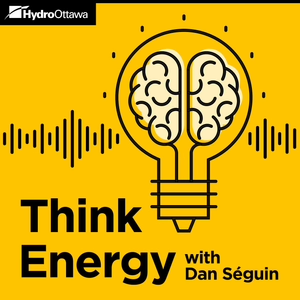
03/15/21 • 35 min
Passive homes - how do they compare to a so-called “regular” house? And what can homeowners expect with respect to their carbon footprint and future energy bills? To talk about these high performance homes and the steps it takes to shift to varying degrees of eco-conscious living, we've invited Casey Gray, the founder of an award winning sustainable building company, The Conscious Builder, and the host of the Conscious Builder podcast.
Related Content & Links:
- Casey Grey
- Twitter: @CaseyAGrey
- Linkedin: https://www.linkedin.com/in/caseygrey/
- The Conscious Builder
- Twitter: @BuildConscious
- Linkedin: https://www.linkedin.com/company/the-conscious-builder/
- Website: https://www.theconsciousbuilder.com/
- Instagram: https://www.instagram.com/the_conscious_builder
- Resources
- The Conscious Builder podcast: https://www.theconsciousbuilder.com/podcast
--
Transcript:
Dan Seguin 00:43
Welcome back, everyone to our latest episode of The ThinkEnergy podcast, the rise in green construction is projected to reach $460 billion globally by 2022. It's a clear sign that more of us are embracing cleaner living and a desire to tackle climate change, and carbon emissions from the comfort of our home. Did you know that 111 million tons of greenhouse gas emissions are released into the atmosphere every year from Canadian homes and buildings. In fact, approximately 60% of Canada's energy usage is from heating and cooling our buildings. When it comes to home design and construction, passive homes and other low impact builds are changing the building landscape thanks to informed and environmentally conscious consumers. At a high level, a passive home works with its environment, reducing the need for additional energy for heating and cooling. Some factors include how a home is positioned or oriented on the parcel of land, how it makes use of sunlight as an energy source, its air tightness and overall indoor air quality. Net-zero and passive homes don't look any different from other recently built homes - even on the inside, most of what makes the home efficient is happening behind the walls, in the foundation or on the roof. Perhaps the surest way to tell a passive home from a regular home would be to look at its utility bill. Certified passive homes are 80-90% more energy efficient than a typical home built to code. And as demand rises, and costs fall, energy efficient homes are paying for themselves faster than ever before. That being said, awareness and incentives may be the keys to greater adoption. According to the Canadian Home Builders Association, there are only 456 certified netzero buildings in the country. And according to passive house Canada, there are currently only 67, certified residential, commercial and institutional buildings. So here is today's big question. What exactly goes into a passive home? And what can homeowners expect with respect to their carbon footprint and future energy bills? To talk about these high performance homes, we've invited Casey Gray, the founder of an award winning sustainable building company, The Conscious Builder, and the host of the Conscious Builder podcast. Okay, let's get started. Casey, thanks for joining us today. Perhaps you can tell us a bit about yourself, your background and what's led you to sustainable building?
Casey Gray 04:05
Yeah, I guess I have to go back a little bit. My background, I guess if you want to call it back to when I skipped born raised in Ottawa, so I've been in Ottawa my whole life, in the east end of Ottawa at the beginning and then moved to the west end and south and all over the place since I've been in construction, essentially, and married and very happily been with my wife going on 16 we're trying to figure this out the other day, like married seven years later, 16 years, I think at this point. We have a seven year old, who's doing great, so very happy with that. We're navigating the school system like everybody else who has kids. Luckily, we have one to deal with. So I'm sure with multiple kids, it's a lot more difficult. So I'm not complaining by any means, that's for sure. So that's all great. But the reason why I mentioned that is actually because my family is kind of what led me into the symbol building portion. So I've been in construction since after high school went and did my apprenticeship became a carpenter and started running jobs. My guy's 21 when I ran my first job, actually, I think I was younger than that. But in either case I went on my own in my early 20s, and kind of have been growing since then. But whe...
Show more best episodes

Show more best episodes
FAQ
How many episodes does ThinkEnergy have?
ThinkEnergy currently has 162 episodes available.
What topics does ThinkEnergy cover?
The podcast is about Energy, Podcasts, Technology, Science and Communications.
What is the most popular episode on ThinkEnergy?
The episode title 'The Power of Influence' is the most popular.
What is the average episode length on ThinkEnergy?
The average episode length on ThinkEnergy is 34 minutes.
How often are episodes of ThinkEnergy released?
Episodes of ThinkEnergy are typically released every 14 days.
When was the first episode of ThinkEnergy?
The first episode of ThinkEnergy was released on May 23, 2019.
Show more FAQ

Show more FAQ
Comments

@dseguin819
Jun 26
Topic is very interesting and for those considering influencer marketing , quite relevant
Like
Reply